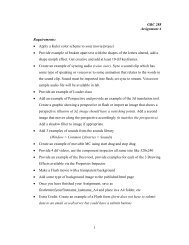Introducing Financial Accounting - CCSN Computer Graphics Program
Introducing Financial Accounting - CCSN Computer Graphics Program
Introducing Financial Accounting - CCSN Computer Graphics Program
You also want an ePaper? Increase the reach of your titles
YUMPU automatically turns print PDFs into web optimized ePapers that Google loves.
wiL27041_ch01_002-047.indd Page 10 10/4/10 7:12:28 PM user-f499 /Volumes/204/MHBR211/wiL27041_disk1of1/0073527041/wiL27041_pagefiles<br />
10 Chapter 1 <strong>Introducing</strong> <strong>Financial</strong> <strong>Accounting</strong><br />
EXHIBIT 1.7<br />
Building Blocks for GAAP<br />
Point: The cost principle is also called<br />
the historical cost principle.<br />
For updates on this joint FASB and IASB conceptual framework convergence we can check<br />
with FASB.org or IASB.org.uk Websites. We must remember that U.S. GAAP and IFRS are<br />
two similar, but not identical, systems. However, their similarities greatly outweigh any differences.<br />
The remainder of this section describes key principles and assumptions of accounting.<br />
Principles and Assumptions of Ac counting <strong>Accounting</strong> principles (and assumptions)<br />
are of two types. General principles are the basic assumptions, concepts, and guidelines<br />
for preparing financial statements. Specific principles are detailed rules used in reporting business<br />
transactions and events. General principles stem from long-used accounting practices. Specific<br />
principles arise<br />
more often from the<br />
Principles<br />
Assumptions<br />
Constraints<br />
Decision Insight<br />
Principles and Scruples Auditors, directors, and lawyers are using<br />
principles to improve accounting reports. Examples include accounting<br />
restatements at Navistar, financial restatements at Nortel, accounting<br />
reviews at Echostar, and expense adjustments at Electronic Data Systems.<br />
Principles-based accounting has led accounting firms to drop clients<br />
deemed too risky. Examples include Grant Thornton’s resignation<br />
as auditor of Fremont General due to alleged failures in providing information<br />
when promised, and Ernst and Young’s resignation as auditor of<br />
Catalina Marketing due to alleged accounting errors. ■<br />
Measurement<br />
Full<br />
disclosure<br />
Going<br />
concern<br />
Monetary<br />
unit<br />
GAAP<br />
GAAP<br />
Revenue<br />
recognition<br />
Expense<br />
recognition<br />
Time<br />
period<br />
Business<br />
entity<br />
Materiality Benefits > Cost<br />
rulings of authoritative<br />
groups.<br />
We need to understand<br />
both general<br />
and specific principles<br />
to effectively use accounting<br />
information.<br />
Several general principles<br />
are des cribed in<br />
this section that are<br />
relied on in later chapters.<br />
General principles<br />
(in purple font<br />
with white shading)<br />
and assumptions (in<br />
red font with yellow shading) are portrayed as building blocks of GAAP in Exhibit 1.7. The<br />
specific principles are described as we encounter them in the book.<br />
<strong>Accounting</strong> Principles General principles consist of at least four basic principles, four assumptions,<br />
and two constraints.<br />
The measurement principle, also called the cost principle, usually means that accounting<br />
information is based on actual cost (with a potential for subsequent adjustments to market). Cost is<br />
mea sured on a cash or equal-to-cash basis. This means if cash is given for a ser vice, its cost is<br />
meas ured as the amount of cash paid. If something besides cash is exchanged (such as a car traded<br />
for a truck), cost is measured as the cash value of what is given up or received. The cost principle<br />
emphasizes reliability and verifiability, and information based on cost is considered objective. Objectivity<br />
means that information is supported by independent, unbiased evidence; it demands more<br />
than a person’s opinion. To illustrate, suppose a company pays $5,000 for equipment. The cost<br />
principle requires that this purchase be recorded at a cost of $5,000. It makes no difference if the<br />
owner thinks this equipment is worth $7,000. Later in the book we introduce fair value measures.<br />
Revenue (sales) is the amount received from selling products and services. The revenue<br />
recognition principle provides guidance on when a company must recognize revenue. To









